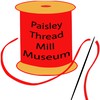
Paisley Thread Mill Museum was founded in 2003 to tell the story of the Clarks and Coats Thread Mills of Paisley, Today we tell the story of Thread Making in Paisley from it's origin in 1722 to the close of the last mill in 1993. Our exhibits are themed, spread over 15 display cases and interactive digital image & video archives.
Open on a Wednesday and Saturday afternoon, all year round, we look forward to welcoming you during your visit to Paisley. During 2017 we explored Paisley & Renfrewshire's thread manufacturing industry through funding from HLF and Renfrewshire Council. Where and when did the tread industry begin? How fast did it develop?
Open on a Wednesday and Saturday afternoon, all year round, we look forward to welcoming you during your visit to Paisley. During 2017 we explored Paisley & Renfrewshire's thread manufacturing industry through funding from HLF and Renfrewshire Council. Where and when did the tread industry begin? How fast did it develop?
Services
Paisley Thread Mill Museum aims to preserve the social and industrial heritage of the Paisley & Renfrewshire Thread Mills for the education and enjoyment of all by collecting and displaying material relating to the the thread industry. Many of the items of display have been donated by people who were connected with the local thread mills and include photographs, mill machinery, samples of products made there and sewing artefacts.
Paisley has had a textile industry dating back to medieval times. The origins of the thread industry really begin to appear after 1722 when Christian Shaw of Bargarran in Erskine (best known as the instigator of the Bargarran Witch Hunt of 1696 at the age of 11) began spinning a fine linen thread at Bargarran House, and creating the Bargarran Thread Company.
Paisley Thread Mill Museum is in the Mile End Mill building of the Abbey Mill Business Centre, on Seedhill Road. Car Parking is available in the Abbey Mill Business Centre Car Park. When you arrive at reception, please give your car registration number to the receptionist or one of our volunteers. If you do not do this you risk a parking fine.
Coats Land is a 150 mile stretch of land on the coast of the Antarctic. It was discovered by the Scottish National Arctic Exhibition (1902-1904) led by William S Bruce on the research ship "The Scotia". It was named after Major Andrew Coats and his younger brother James Coats junior of the Paisley thread-making company who provided over 30,000 towards financing the venture.
Andrew Crummy, Scottish artist and designer - who drew the panels for the Battle of Prestonpans, the Great Tapestry of Scotland and the Scottish Diaspora Tapestry - will be working together with an eclectic group of people to create a tapestry for Renfrewshire. It will be a celebration of the amazing global importance of this part of Scotland, a tourism draw and have its part to play in the City of Culture bid 2021.
Reviews (7)
Helen Alfa
Nov 25, 2021
Report
Alan Gilmour
Oct 22, 2021
Report
Hamish Connor MacLeod
Dec 19, 2019
Report
Barbara Hanna
Sep 13, 2019
Report
Yair Lopez
Jan 19, 2019
Report
Paul Dickson
Nov 07, 2018
Report
Pete Taylor
Dec 24, 2016
Report
Good points are that this is keeping alive one of the major contributions to Paisley's existence. Not really big enough space and lacking in substance but at least it's still alive! Only open Wednesdays during October to March and then only opened Wednesdays and Saturdays the rest of the year. Wouldn't go just to see the museum but if your in the area on the correct day, why not go along?


